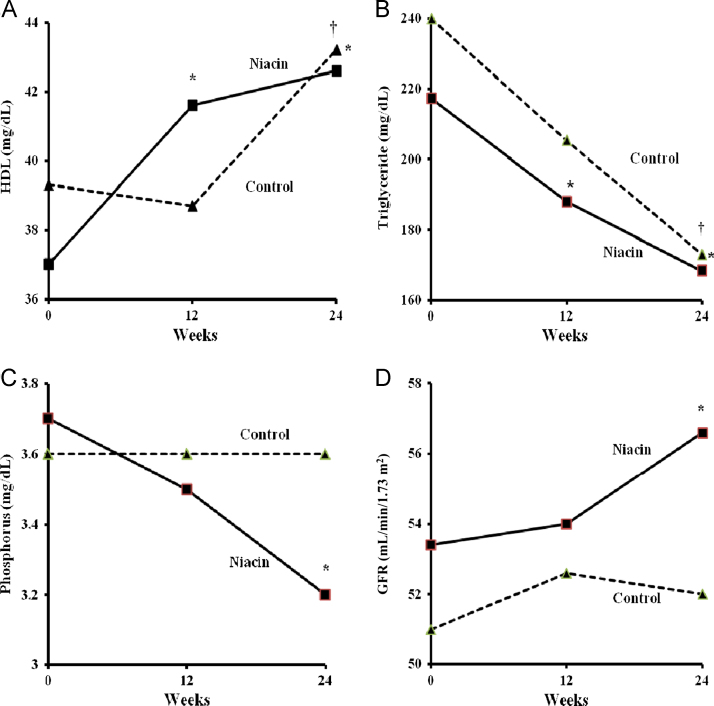| Kidney Res Clin Pract > Volume 32(1); 2013 > Article |
|
Abstract
Background
Methods
Results
Conclusion
Keywords
Adverse effects, Dyslipidemia, Glomerular filtration rate, Niacin, PhosphorusReferences
Figure. 1

Table 1
Table 2
Data are expressed as mean±SD, except random urine P/C ratio and random urine A/C ratio, which were expressed as mean±SE.
GFR, MDRD-estimated glomerular filtration rate; HDL, high-density lipoprotein cholesterol; LDL, low-density lipoprotein cholesterol; MDRD, modification of diet in a renal disease study; RU A/C ratio, random urine albumin-to-creatinine ratio; RU P/C ratio, random urine protein-to-creatinine ratio; SGOT, serum glutamic oxaloacetic transaminase (aminotransferases); SGPT, serum glutamic pyruvic transaminase (alanine aminotransferase).
Table 3
| Control group (baseline) | Control group (24 wks) | Niacin group (baseline) | Niacin group (24 wks) | |
|---|---|---|---|---|
| Systolic BP (mmHg) | 129.4±2 5.0 | 124.6±15.2 | 124.8±20.8 | 124.5±18.0 |
| Diastolic BP (mmHg) | 77.1±15.4 | 77.6±12.4 | 77.3±12.0 | 72.3±17.8 |
| Hemoglobin (g/dL) | 12.9±2.2 | 12.7±2.2 | 12.9±1.8 | 12.8±1.8 |
| Platelet count (103/μL) | 216.0±65.2 | 219.0±60.9 | 231.5±56.9 | 221.0±62.6⁎ |
| Calcium (mg/dL) | 9.0±0.4 | 8.8±0.4⁎ | 9.1±0.5 | 9.0±0.4 |
| Phosphorus (mg/dL) | 3.6±0.5 | 3.6±0.6 | 3.7±0.6 | 3.2±0.7⁎ |
| Calcium–phosphorus product (mg2/dL2) | 32.3±4.8 | 32.1±5.3 | 33.8±5.8 | 28.9±6.0⁎ |
| Blood urea nitrogen (mg/dL) | 24.3±11.0 | 24.5±11.8 | 22.0±11.1 | 23.1±6.5 |
| Creatinine (mg/dL) | 1.6±0.7 | 2.0±2.0 | 1.5±0.7 | 1.4±0.7 |
| GFR (mL/min/1.73 m2) | 51.0±19.6 | 52.0±22.2 | 53.4±22.0 | 56.6±24.3⁎ |
| Albumin (g/dL) | 4.2±0.3 | 4.2±0.4 | 4.3±0.3 | 4.4±0.2 |
| Uric acid (mg/dL) | 7.0±1.6 | 7.4±1.6 | 6.8±2.0 | 6.4±1.8⁎ |
| SGOT (IU/L) | 22.3±8.0 | 23.1±8.6 | 21.5±8.9 | 23.5±10.7 |
| SGPT (IU/L) | 23.0±11.5 | 24.9±16.1 | 20.9±11.4 | 22.7±17.4 |
| Alkaline phosphatase (IU/L) | 241.4±99.2 | 246.7±66.3 | 254.9±71.2 | 274.4±82.2⁎ |
| Total cholesterol (mg/dL) | 182.4±48.2 | 173.1±47.9 | 178.5±34.2 | 162.0±28.5 |
| Triglyceride (mg/dL) | 239.4±192.1 | 173.0±101.9⁎ | 221.1±1 12.9 | 168.4±100.2⁎ |
| HDL (mg/dL) | 39.3±7.4 | 43.2±9.1⁎ | 37.0±8.2 | 42.6±8.2⁎ |
| LDL (mg/dL) | 98.5±33.0 | 91.3±33.9 | 93.5±26.7 | 87.2±24.7 |
| C-reactive protein (mg/dL) | 0.1±0.1 | 0.1±0.1 | 0.3±0.6 | 0.3±0.5 |
| HbA1c | 6.8±2.1 | 6.9±1.5 | 7.0±1.7 | 6.6±0.8 |
| RU P/C ratio (g/g) | 1.3±0.4 | 1.4±0.4 | 1.1±0.5 | 1.2±0.5 |
| RU A/C ratio (mg/g) | 209.4±70.5 | 169.8±62.0 | 227.1±54.9 | 195.5±63.3 |
BP, blood pressure; GFR, MDRD-estimated glomerular filtration rate; HDL, high-density lipoprotein cholesterol; LDL, low-density lipoprotein cholesterol; MDRD, modification of diet in a renal disease study; RU A/C ratio, random urine albumin-to-creatinine ratio; RU P/C ratio, random urine protein-to-creatinine ratio; SGOT, serum glutamic oxaloacetic transaminase; SGPT, serum glutamic pyruvic transaminase.



 PDF Links
PDF Links PubReader
PubReader Full text via DOI
Full text via DOI Download Citation
Download Citation Print
Print
















